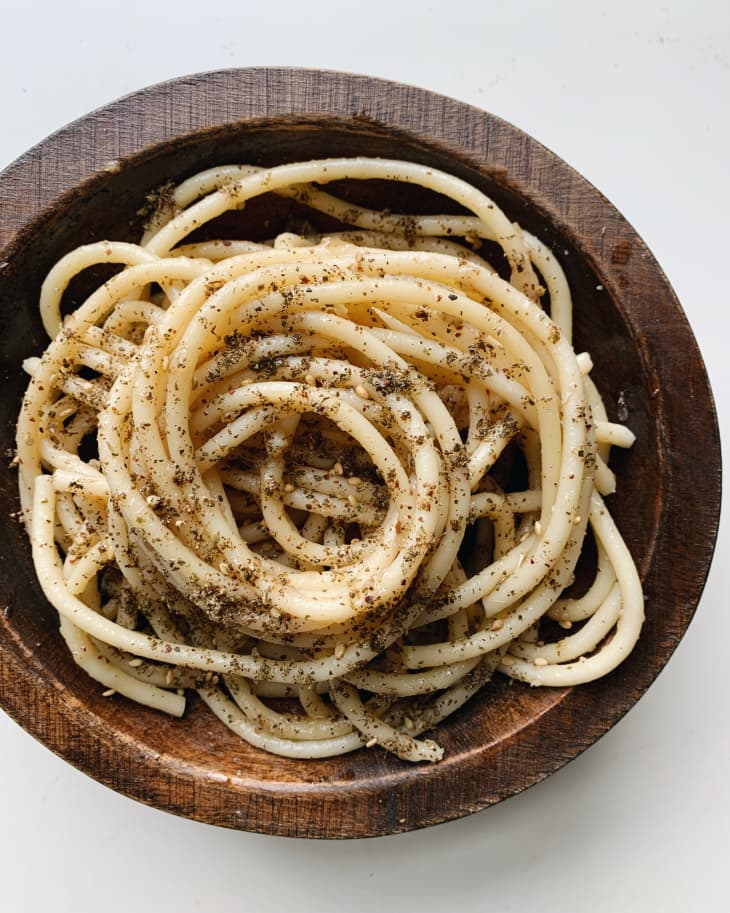I Tried This Surprising Cacio e Pepe Upgrade and Couldn’t Believe the Results
I’ve always favored simple pasta dishes over fancier ones. I regularly toss spaghetti with Marcella Hazan’s four-ingredient tomato sauce, and get an incredible amount of pleasure out of the most basic classic Italian pastas, such as pasta alla gricia and cacio e pepe.
Earlier this year, I finally mastered the perfect cacio e pepe: silky and creamy, and totally foolproof. So when I caught a glimpse of a cacio e pepe recipe in Yotam Ottolenghi and Ixta Belfridge’s new cookbook, Flavor, I almost skipped right over it. After all, I already had a winning recipe!
But then I looked more closely. Their cacio e pepe recipe is bolstered by za’atar, the Middle Eastern spice blend of sesame seeds, dried thyme or oregano, and sumac. As a pasta purist, I was dubious of this twist. Yet za’atar is one of my very favorite spice blends, so I knew I had to give the recipe a try. Here’s how it went.
Get the recipe: Za’atar Cacio e Pepe
How to Make Za’atar Cacio e Pepe
In addition to the za’atar, the technique for making the cacio e pepe sauce was new to me, too. You’ll start by bringing seven cups of water to a boil in a wide, high-sided pan. Season it with salt, add a pound of dried bucatini pasta, and cook until al dente. Drain the pasta but reserve all of the pasta water.
Next, you’ll melt butter in the pan, add a generous amount of za’atar and freshly cracked black pepper, and sauté the spices for a minute until they’re fragrant. You’ll then pour all of the reserved cooking water into the pan, bring it to a boil, and simmer the mixture for about five minutes, until it’s reduced and slightly thickened.
Once the spiced pasta water is silky, you’ll add the al dente pasta, then stir in a lot of grated Parmesan and Pecorino Romano cheeses to melt. Continue to simmer the mixture and stir until any excess liquid has evaporated and the pasta is well coated in creamy, cheesy sauce. You’ll finish the pasta with more za’atar and a drizzle of olive oil before digging in.
My Honest Review of Za’atar Cacio e Pepe
While I’ll never give up a bowl of classic Italian cacio e pepe, I absolutely loved this surprising twist. To me, it felt like an entirely different pasta dish. It was indeed cheese- and pepper-forward, like any good cacio e pepe, but the addition of za’atar gave it a personality all its own. The spice blend lent an herbal, zippy quality to each twirl that was really unique. Typically, I don’t like butter in cacio e pepe pasta, but seeing as this recipe didn’t claim authenticity from the get-go, I didn’t mind the added richness it brought — especially because the tangy za’atar counterbalanced it.
The technique itself really stood out, too. I did unfortunately have trouble finding a pan that was wide and deep enough to cook the pasta. (My large Le Creuset Braiser would have worked perfectly, but at the time I was at my dad’s house without it). So aside from some sloshing due to a less-than-ideal pan, I thought the idea of cooking the pasta in a smaller amount of water and saving all of the extra starchy pasta water to make a silky sauce was smart.
A Few Tips for Making Za’atar Cacio e Pepe at Home
There were just a few things that tripped me up in the process of making this recipe, so these tips will help set you up for success it you try it yourself.
- Reach for your widest, deepest pan. As I mentioned, it really helps to have the proper pan here. Rather than cooking your dried bucatini pasta in a large pot, you’ll be cooking it in a wide, deep pan, so grab something that will easily fit a full pound of the long pasta and the seven cups of water.
- Cook the pasta just shy of al dente. While the recipe says to cook the paste to al dente, you’ll be cooking it a few minutes more in the sauce, so I suggest draining it a minute or two before it’s al dente. That way you don’t have to worry about mushy noodles.
- Drain the pasta water into a large, spouted bowl, if you have one. You’ll be saving all of the pasta water when you drain the pasta, so it’s useful to set your colander over a large, heatproof bowl with a pourable spot (aka a batter bowl). That way you can easily pour the hot water back into the pan when you need it without making a mess.
- Use the same pan you cooked the pasta in to make the sauce. Don’t bother dirtying another pan to make the sauce. After you drain the pasta, return the pan to the stove and begin melting the butter.
